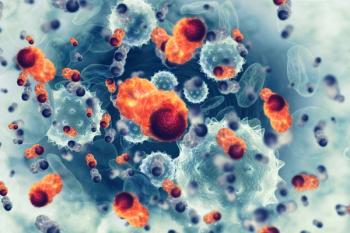
Low Platelet Count Observed in Treatment Associated With Myelofibrosis
According to the phase 3 PERSIST-1 trial and PAC203 trial, thrombocytopenia was associated with myelofibrosis treatment.
Symptom burden associated with myelofibrosis treatment included low platelet counts compared with low hemoglobin, which is based on findings from the phase 3 PERSIST-1 (NCT01773187) and PAC203 (NCT03165734), and were presented at the
“In this retrospective analysis, patients with isolated thrombocytopenia had more severe symptom burden than those with isolated anemia, particularly with physical function- and spleen-related symptoms. These data suggest that anemia is not the sole driver of symptom burden among patients with cytopenia myelofibrosis,” Jeanne M. Palmer, MD, vice chair and section chief for Hematology, and director of the Blood and Marrow Transplant Program at Mayo Clinic in Phoenix, Arizona, and coauthors wrote in the poster.
Cytopenias have been shown to cause poor survival and increased symptom burden in patients with myelofibrosis. Moreover, the presence of thrombocytopenia is associated with worse fatigue, inactivity, early satiety, and quality of life in patients compared with those who have higher platelet counts.
Although thrombocytopenia and anemia often occur concomitantly in myelofibrosis, their effects on disease-related symptoms are not well known. As such, investigators sought to evaluate whether anemia is the primary driver of disease-related symptoms in cytopenic patients.
To do this, investigators compiled data from the PERSIST-1 and PAC203 trials, which had enrolled patients with myelofibrosis regardless of platelet count or hemoglobin. Patients who received ruxolitinib (Jakafi) within 30 days prior to randomization were excluded.
Investigators used total symptom score (TSS) v.1.0 in 55% of patients in PERSIST-1 and v2.0 was used for the rest of patients in PERSIST-1 and all patients in PAC203. Evaluated symptoms included tiredness/fatigue, early satiety, abdominal discomfort, left rib pain, night sweats, itching, and bone pain.
A difference in total score of 4.3 was used to define the minimal clinically important difference.
Patients with low hemoglobin (n = 20), defined as platelet count at or above 100 x 109/L and hemoglobin below 8 g/dL, had higher rates of red blood cell transfusion dependence, higher Dynamic International Prognostic Scoring System risk scores, and small spleens based on palpation, compared with patients with low platelets (n = 113), which was defined as platelet count below 100 x 109/L and hemoglobin of at least 8 g/dL. The age and percentage of patients with prior JAK2 exposure was similar between the 2 groups.
Patients with low platelets had worse TSS vs patients with low hemoglobin, suggesting more severe disease-related symptoms in this population. Notably, a minimal clinically important difference in TSS was reported between groups in the PERSIST-1 trial using v1.0 (low platelets, 18.6; low hemoglobin, 12.2) and the PAC203 trial using v.2.0 (low platelets, 29.0; low hemoglobin, 24.7).
In terms of individual symptom scores, patients with low platelets experienced more fatigue and inactivity compared with those with low hemoglobin. Additionally, physical function domain scores were worse in patients with low platelets in the PERSIST-1 trial using v.1.0 and v2.0, as were severe symptoms of splenomegaly compared with those with low hemoglobin.
Furthermore, spleen-related symptoms scores were worse in patients with low platelets in all 3 evaluated groups.
Notably, cytokine-related symptoms presented in similar severity in patients with low platelets and low hemoglobin.
“While amelioration of anemia is an important therapeutic goal for patients with cytopenic myelofibrosis, additional efforts aimed at control of platelet count and underlying disease should be implemented to achieve optimal symptom control,” the authors concluded.
Reference
Palmer JM, Gerds AT, Harrison C, et al. Differential impact of thrombocytopenia and anemia on myelofibrosis (MF) symptom burden. Blood. 2022;140(suppl 1):3938-3940. doi:10.1182/blood-2022-156702
Newsletter
Stay up to date on recent advances in the multidisciplinary approach to cancer.
















































































